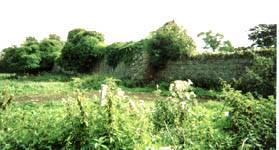Margaret O'Carroll
We seldom get enough information from medieval sources to enable us to picture the everyday lives and characters of women. Margaret O'Carroll is one woman whose life we can partly reconstruct and her activities suggest considerable independence for a married woman of the Gaelic aristocracy at that time.
Daughter of the chieftain of Ely O'Carroll in the midlands, she married another midland chieftain, Calvagh O'Conor Fálghe, but she became famous in her own right for issuing general invitations of hospitality to poets and writers to the abbey at Killeigh near Tullamore during the 'hungry summer' of 1433.
On the day of the assembly, it is claimed that there were some 2,700 people in the village, 'all persons both Irish and Scotish or rather Albians ... besides gamesters and poore men.'
Liz FitzPatrick in Journal of the Co. Kildare Archaeological Society. Vol. XVIII, 1992-3, p. 29. |
|
'Margarett on the garretts of the greate church of Da Sincheall clad in cloath of golde, her dearest friends about her, her clergy and judges too. Calwagh himself being on horseback by the churchs outward side, to the end that all things might be done orderly and each one served successively.'
Annals of Mac Firbis
|
|
She also nursed or fostered two orphans on that day. In 1445, Margaret and several members of the nobility in Ireland made a pilgrimage to Compostella in Spain. This would have involved sailing for about six weeks from the South of Ireland to Spain followed by about a week's journey over land on foot or on horseback. They could have been four months away from home and three members of the party died during the pilgrimage.
|

Monastic ruins at Killeigh |
Her husband Calvagh went on a raid against a neighbouring territory while she was away. His troops burnt towns, cut down corn and took hostages but Margaret released the hostages on her return and did a deal for them without Calvagh's advice
'... and that unadvised to Calwagh'. This she would have been allowed to do by an early Irish or brehon law of marriage.
The Cán Lanamhna states that women may give a third of their honour-price in security on 'behalf of their friends in fetters and chains'.
Liz FitzPatrick in Journal of the Co. Kildare Archaeological Society, Vol. XVIII, 1992-3, p. 33. |
Margaret would have brought a large dowry on her marriage, most likely in the form of cattle. Under the Brehon law, she obviously had wealth at her own disposal for hospitality, travel and exchanging hostages. She seems to have had five sons and two daughters. She died from breast cancer in 1451 and it was reported that one of her sons died the following day from 'the unmentionable disease, leprosy.'
The men in Margaret's life were noted for being generous and endowing monasteries but also for military activities, cattle raids, demanding tribute and taking spoils . Her father and three of her sons died violent deaths.
Her daughter Finola, also a spirited woman, was married first to Niall O'Donnell of T? Conaill who was arrested by the English and died in prison in the Isle of Man. Her second husband, Aodh Buidhe O'Neill of Co.Antrim died after twenty-five days in agony from 'one cast of a speare.' Finola retired, a widow, to the O'Conor abbey at Killeigh and lived there as an Augustinian canoness for forty-nine years until her death in 1493.
Questions
- Margaret O'Carroll was daughter of _______ and married to _________.
- Why did Margaret O'Carroll become famous in 1433?
- Margaret went on pilgrimage to _________ in _________ in the year _____, and could have been ______ months away from home.
- How did Calvagh O'Conor displease her while she was away?
- What did she do on her return to show her displeasure?
- What evidence is there to show that she enjoyed considerable independence?
- Write a short paragraph about her family.
Activities
- Make a drawing or painting of the scene at the great church of Da Sincheall at Killeigh in 1433.
- Write a report for a popular newspaper about Margaret O'Carroll's activities on her return from pilgrimage in Spain.
- Role play a conversation between Margaret and Calvagh on her return from Spain.
- Role play a conversation between Margaret and her daughter Finola.
- Write an obituary for Margaret O'Carroll.
- Role play an interview with Calvagh O'Conor.
